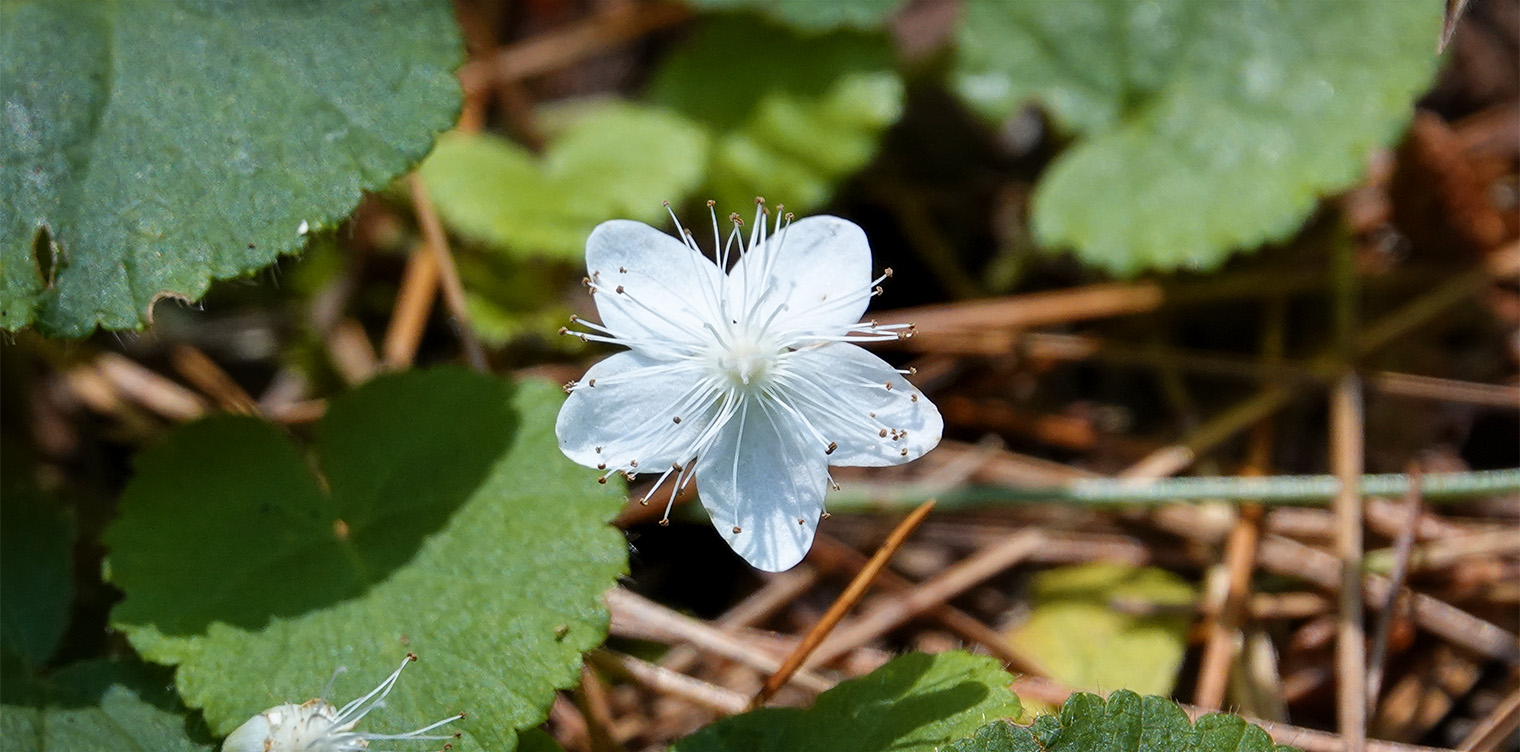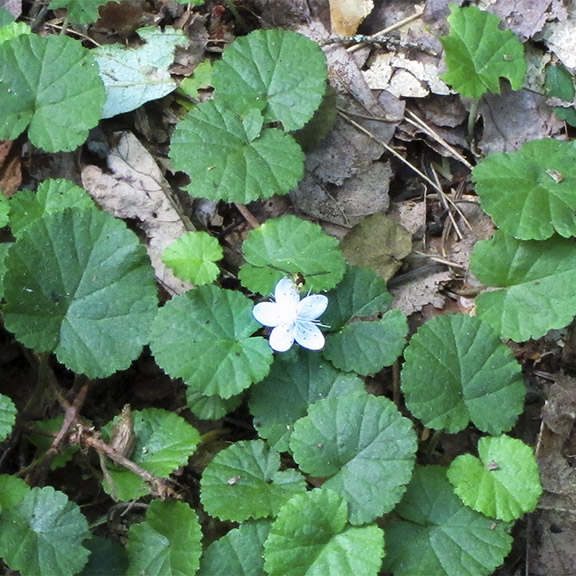Wildflowers of the Adirondacks:
Dewdrop (Dalibarda repens)

Dewdrop (Dalibarda repens) is a native wildflower with rounded, heart-shaped leaves and small white flowers that appear in summer. It grows in moist forests in the Adirondack Mountains of upstate New York.
A member of the rose family, this plant is also known as False Violet, Robin Runaway, Robin-run-away, and Star Violet. The name False Violet comes from its heart-shaped leaves and the fact that this species, like violets, produces two kinds of flowers. No information was found on the origin of the common names Robin Runaway or Dewdrop.
Identification of Dewdrop

Dewdrop is a low-growing plant, growing less than 6" tall. The creeping stems are often shallowly buried.
Dewdrop leaves are dark green and heart-shaped at the base. The leaves are slightly hairy. They are long-stalked and are up to two inches long and wide. The margins of Dewdrop leaves are scalloped, with low, rounded teeth.
Dewdrop produces two types of flowers. The ones we observe along the trail are open, white flowers, generally about half an inch wide, with five petals and numerous slender stamens. These flowers appear singly on a reddish, leafless stalk. The second type of flower is fertile. It lacks petals and is hidden beneath the leaves.
Dewdrop is one of the few shade-tolerant woodland ground cover species which flowers in summer. It usually begins blooming in late June or early July and continues blooming through late August.
Uses of Dewdrop
Dewdrop has very limited human uses. The only medicinal use found was by the Iroquois, who are said to have used a decoction of powered plants as a blood purifier and a treatment for venereal disease.
Wildlife Value of Dewdrop
This species has no reported value as a wildlife food or cover.
Distribution of Dewdrop
Dewdrop's range includes Ontario east to Nova Scotia, south to North Carolina, and northwest to Ohio, Michigan and Minnesota. Dewdrop is listed as endangered in Connecticut, New Jersey, North Carolina, and Rhode Island, and threatened in Michigan and Ohio.
In New York State, Dewdrop may be found in most counties in the northeastern part of the state. In the Adirondack Park, Dewdrop occurs in all counties within the Blue Line, except Clinton, Herkimer, and Warren counties.
Habitat of Dewdrop
Dewdrops are shade-tolerant. They can grow in shade and part-shade, on well- to poorly drained sites, often under conifers. This species can be found in cool, moist hardwood and coniferous forests, mixed woods forests, and on hummocks in forested swamps and boggy areas.
In the Adirondack Park, Dewdrop is found in several ecological communities, including:
Look for Dewdrops along many of the trails highlighted here, including the Sucker Brook Trail at the Adirondack Interpretive Center in Newcomb, the Peninsula Nature Trails, Bloomingdale Bog Trail, the Barnum Brook Trail, Heron Marsh Trail, Boreal Life Trail, Silvi Trail, and Black Pond Trail.
References
Michael Kudish. Adirondack Upland Flora: An Ecological Perspective (The Chauncy Press, 1992), p. 152.
New York Flora Association. New York Flora Atlas. Dewdrop. Rubus repens (L.) Kuntze. Retrieved 26 March 2017.
United States Department of Agriculture. The Plants Database. Robin Runaway. Dalibarda repens L. Retrieved 26 March 2017.
Flora of North America. Rubus repens (Linnaeus). Retrieved 26 March 2017.
NatureServe Explorer. Online Encyclopedia of Life. Robin-run-away. Rubus repens - (Linnaeus) Kuntze. Retrieved 26 March 2017.
New York State. Department of Environmental Conservation. New York Natural Heritage Program. Ecological Communities of New York State. Second Edition (March 2014), pp. 72, 122, 122-123. Retrieved 17 October 2015.
New York Natural Heritage Program. 2021. Online Conservation Guide for Balsam Flats. Retrieved 24 July 2021.
New York Natural Heritage Program. 2021. Online Conservation Guide for Boreal Heath Barrens. Retrieved 24 July 2021.
New York Natural Heritage Program. 2021. Online Conservation Guide for Spruce Flats. Retrieved 24 July 2021.
New York Natural Heritage Program. 2021. Online Conservation Guide for Spruce-Fir Swamp. Retrieved 24 July 2021.
New York State. Adirondack Park Agency. Preliminary List of Species Native Within the Adirondack Park Listed Alphabetically by Scientific Name and Sorted by Habit. Volume 1. Updated 10.23.2006, p. 19. Retrieved 26 January 2017.
Connecticut Botanical Society. Dew-drop (False Violet, Robin-run-away). Rubus dalibarda L. Retrieved 26 March 2017.
Northern Ontario Plant Database. Rubus repens (L.) Kuntze. Retrieved 26 March 2017.
Lady Bird Johnson Wildflower Center. Dalibarda repens L. Retrieved 26 March 2017.
Doug Ladd. North Woods Wildflowers (Falcon Publishing, 2001), p. 215.
Lawrence Newcomb. Newcomb's Wildflower Guide (Little Brown and Company, 1977), pp. 182-183.
Mark J. Twery, et al. Changes in Abundance of Vascular Plants under Varying Silvicultural Systems at the Forest Ecosystem Research and Demonstration Area, Paul Smiths, New York. USDA Forest Service. Research Note NRS-169. Retrieved 22 January 2017, p. 12.
University of Michigan. Native American Ethnobotany. A Database of Foods, Drugs, Dyes and Fibers of Native American Peoples, Derived from Plants. Robin Runaway. Dalibarda repens L. Retrieved 26 March 2017.
Roger Tory Peterson and Margaret McKenny. A Field Guide to Wildflowers. Northeastern and North-central North America (Houghton Mifflin Company, 1968) pp. 32-33.
National Audubon Society. Field Guide to Wildflowers. Eastern Region. (Alfred A. Knopf, 2001), pp. 745-746.
William K. Chapman, et al. Wildflowers of New York in Color (Syracuse University Press, 1998), pp. 10-11.
Charles H. Peck. Plants of North Elba (Bulletin of the New York State Museum, Volume 6, Number 28, June 1899), p. 90. Retrieved 22 February 2017.
